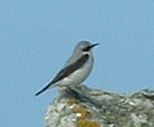Wheatear
|
|
| Wheatears | ||||||||||||
|---|---|---|---|---|---|---|---|---|---|---|---|---|
 Northern Wheatear (male) | ||||||||||||
| Scientific classification | ||||||||||||
| ||||||||||||
| Binomial name | ||||||||||||
| See text | ||||||||||||
| Species | ||||||||||||
|
See text |
The wheatears, genus Oenanthe, were formerly considered to be members of the thrush family Turdidae. They are more commonly now placed in the flycatcher family Muscicapidae. This is an Old World group, but the Northern Wheatear has established a foothold in eastern Canada and Greenland.
They are terrestrial insectivorous passerine birds of open, often dry, country . They often nest in rock crevices or disused burrows.
Northern species are long-distance migrants, wintering in Africa.
Wheatears are typically larger than the European Robin. Most species have characteristic black and white or red and white markings on their rumps or their long tails.
Most species are strongly sexually dimorphic; only the male has the striking plumage patterns characteristic of the genus, though the females share the white or red rump patches.
The wheatear species are:
- Northern Wheatear, Oenanthe oenanthe
- Isabelline Wheatear, Oenanthe isabellina
- Desert Wheatear, Oenanthe deserti
- Black-eared Wheatear, Oenanthe hispanica
- Pied Wheatear, Oenanthe pleschanka
- Cyprus Wheatear, Oenanthe cypriaca
- Finsch's Wheatear, Oenanthe finscii
- Mourning Wheatear, Oenanthe lugens
- Hooded Wheatear, Oenanthe monacha
- White-crowned Wheatear, Oenanthe leucopyga
- Black Wheatear, Oenanthe leucura
- Persian Wheatear or Red-tailed Wheatear, Oenanthe xanthoprymna
- Red-rumped Wheatear, Oenanthe moesta
- Hume's Wheatear, Oenanthe alboniger
- Mountain Wheatear, Oenanthe monticola
- Somali Wheatear, Oenanthe phillipsi
- Variable Wheatear, Oenanthe picata
- Capped Wheatear, Oenanthe pileata
- Red-breasted Wheatear, Oenanthe bottae
- Heuglin's Wheatear, Oenanthe heuglinide:Steinschmätzer (Gattung)
